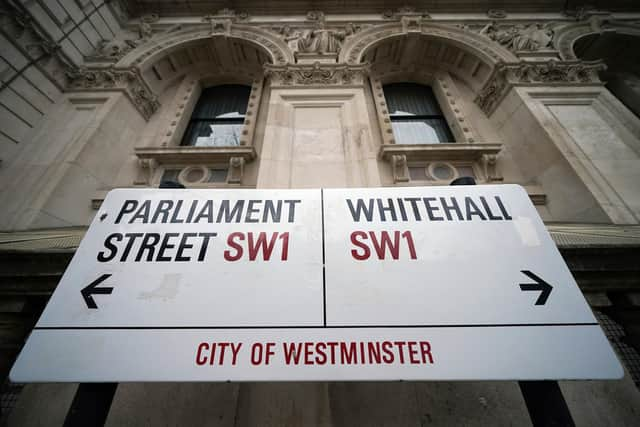Battleground Yorkshire: Whitehall must stop using men as the default when making policy, think tank says
Recent months have seen a great deal of consensus on the main issues, with polling suggesting that both men and women view the cost of living and the NHS as their top priorities.
However, when you dig deeper, there are more specific concerns that the main parties need to address.
Advertisement
Hide AdAdvertisement
Hide Ad“Obviously, women are not one homogeneous group,” says Dr Stephenson, “but it’s important to recognise that women are differently situated in the economy and society”.


Social care and childcare are more likely to come up as issues, with women doing more 60 per cent unpaid work than men, leaving less time for earnings and to build up pensions.
This creates a situation where the effect of policies, which are often geared around men being the default, falls disproportionately on women.
For example, women are on average more likely to be poor, depend on social security, and less likely to benefit from tax cuts, says Dr Stephenson.
Advertisement
Hide AdAdvertisement
Hide AdIn addition, they are likely to be affected by cuts to public services because they’re more likely to work there, need them, and pick up the slack when those services fail.
Though childcare was a major part of the autumn statement, the Conservative focus in recent budgets has been on tax cuts, cutting welfare and future cuts to public services - a manifesto geared towards winning back men voting Reform, rather than women who disproportionately support Labour.
However, women are much more likely to say they are floating voters, with research suggesting last year that 25 per cent, compared to 11 per cent of men, were uncertain of who they would support.
“In 1997, we had all the focus on Worcester Woman, and the need to win women’s votes. To an extent that came from the Labour Party who were aware that women had been more likely to vote Conservative than men - that has now changed,” says Dr Stephenson.
Advertisement
Hide AdAdvertisement
Hide AdThough younger women are particularly more likely to vote Labour, older women are more likely to vote Conservative. The age when that switch happens has slowly risen and is now into the 60s.
“That’s something they really need to look at,” she added.
Part of the problem in addressing this, in an age with greater equality, is that the policies which are largely built by, and broadly for, men are not functioning as well as they did when men made up more of the workforce.
Transport for example, is used differently by men and women, with male journeys geared around commuting in and out and work, while women often “trip-chain” which involves the school run, work, visiting family and the supermarket.
“Our public transport system isn’t set up to facilitate those sorts of trips,” says Dr Stephenson.
Advertisement
Hide AdAdvertisement
Hide Ad“We still have the idea of the male as the default, and women as slightly unusual, rather than recognising that women make up more than half the population.
“If you have a large factory that employs men that closes down, it is a major news story, whereas with the decline of the high street, it is mainly women’s jobs that are disappearing and replaced by jobs in warehouses which are more likely to be taken by men.
“At some level we think of men's employment as more important than women’s employment, even though most families cannot survive without two earners.
“There is still a residual idea that women’s jobs are a little bit about ‘pin money’, they’re nice to have but not fundamental to keeping food on the table and a roof over your head.”
Advertisement
Hide AdAdvertisement
Hide AdWith Rachel Reeves set to be the first female chancellor, it would seem logical that this is about to change, but Dr Stephenson notes that having more women in politics is “necessary but not sufficient to get a focus on issues that affect female voters.
“I think we need more women in politics because we’re more than half the population and should be fairly represented. I also want policies that reflect the needs of women. I don’t think one should be dependent on the other.
“When I first started working on these issues as the Fawcett Society in the mid 1990s, the idea that childcare could be the centerpoint of a budget speech from a chancellor would have been laughed at.
“In fact, when Harriet Harman tried to raise the issue in the 1980s people did actually laugh at her.”
“We’ve still got further to go.”
Advertisement
Hide AdAdvertisement
Hide AdPart of the solution to this, Dr Stephenson says, is through understanding that women should not be an afterthought when drawing up policies.
“If women are more than half the population, and you’re devising a policy that doesn’t really work around women’s needs, then your policy isn’t going to work,” she says, adding that questions which should be “automatic” when drawing up proposals.
“There’s a tendency for policies made in Whitehall to be drawn up by very very clever people who are drawn from quite a narrow group of the population, who don’t necessarily think how a policy will work in a rural constituency in Yorkshire where there isn’t a bus service, or where you can’t get any childcare support.
“The way you convince policymakers that this isn’t just “nice to have” is to focus on what they want, which is how do we make policies that work.
“If you don’t think about the different ways that women and men might experience your policy, then that policy might not work.”